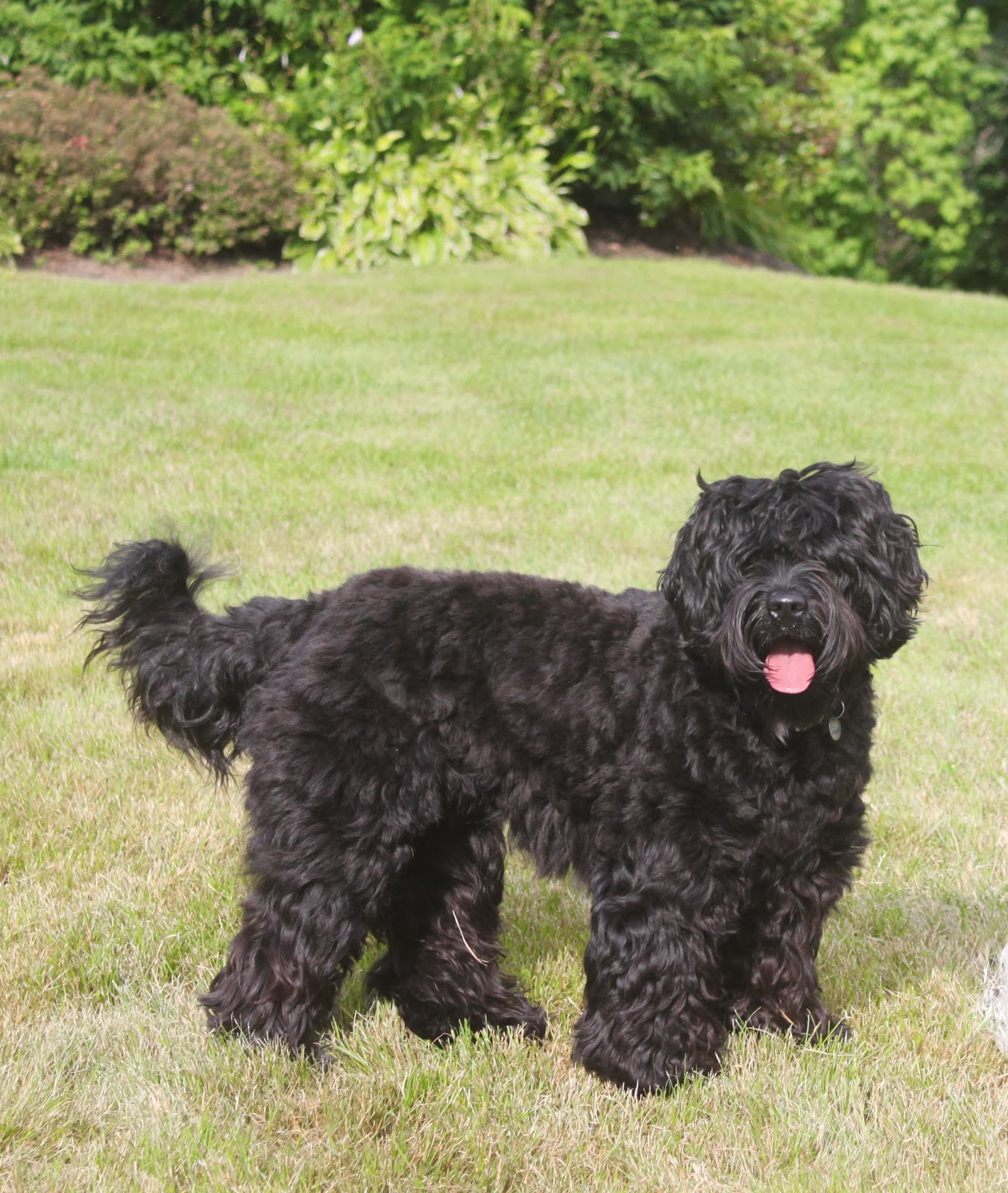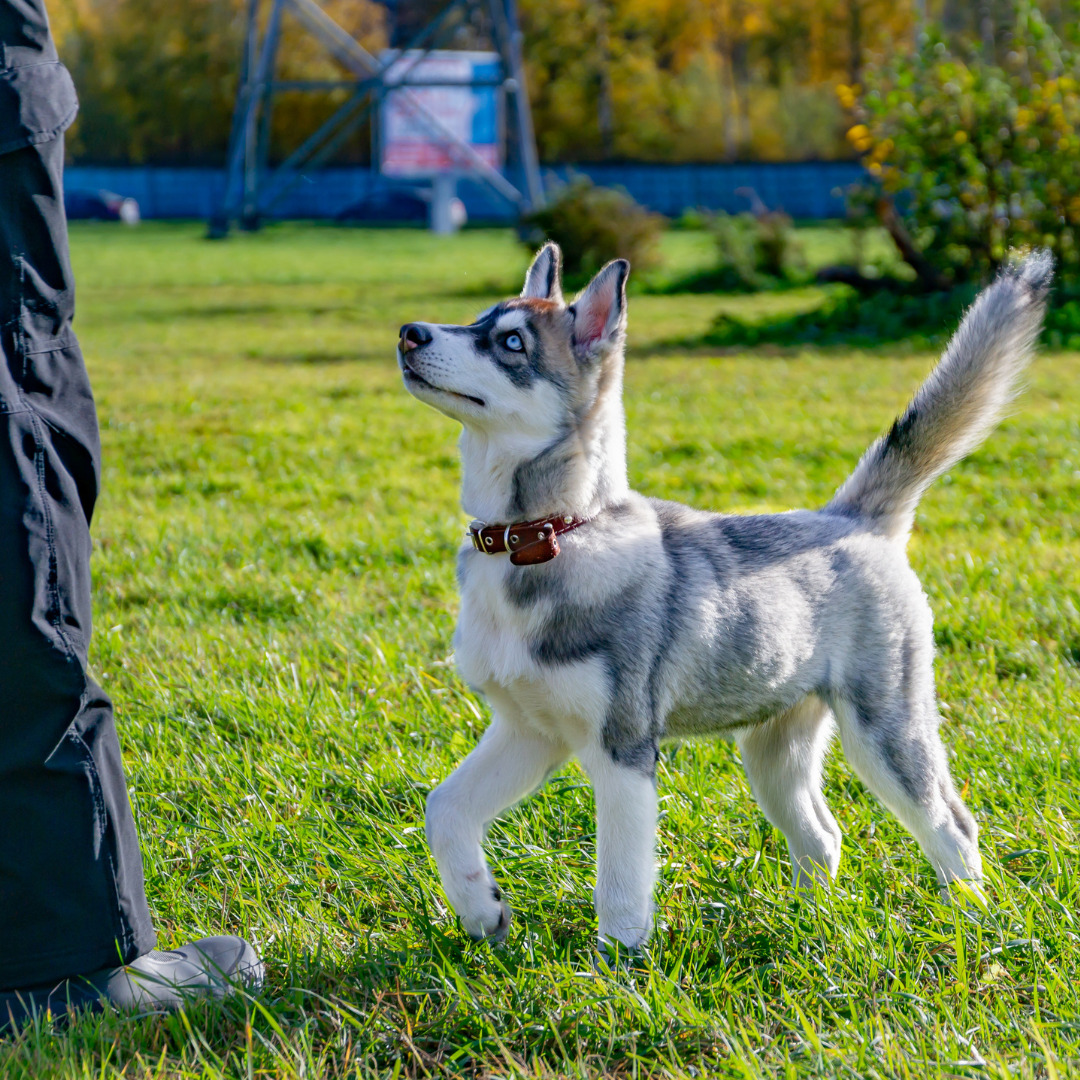Black Labradoodles are highly intelligent dogs with a friendly nature, prized for their hypoallergenic coat. They have a sturdy build with a black coat reflecting Labrador and Poodle lineage. Regular grooming is crucial for their coat health. These dogs require appropriate exercises and socialization to match family dynamics. Training with positive reinforcement is essential for their behavior. Their varying energy levels make matching energy needs vital. Discover more about this captivating breed’s history, characteristics, and care to learn how to best welcome a Black Labradoodle into your family.
History
The history of Labradoodles traces back to their development in the 20th century, originating in Australia in the 1900s through a deliberate crossbreeding program. The first intentional cross between a Labrador and a Poodle occurred in 1989, aimed at creating a hypoallergenic service dog with a friendly and sociable temperament. Labradoodles gained recognition in the early 2000s for their appealing qualities, including high intelligence, mild-mannered demeanor, and suitability for families. The breed’s popularity surged due to its hypoallergenic coat and versatility as a service animal.
Labradoodles have proven to be highly trainable and adaptable companions, excelling in various roles such as therapy and assistance dogs. Their development in Australia has led to the distinction between Australian and American Labradoodles, each with unique characteristics. The breed’s success in agility competitions and obedience training further highlight its exceptional qualities. Efforts by breeders and associations continue in advocating for formal recognition to maintain breeding standards and ensure the preservation of the Labradoodle’s desirable traits.
Breed Origin
With roots stemming from deliberate crossbreeding efforts, can we unravel the intricate origins of the Labradoodle breed?
The Labradoodle, a cross between a Labrador and a Poodle, originated in the late 20th century in Australia. The first intentional mating of these two breeds occurred in 1989, with the aim of creating a hypoallergenic service dog with a gentle temperament.
This innovative crossbreeding endeavor quickly gained popularity, especially for individuals with allergies who desired a canine companion. Labradoodles are known for their intelligence, sociability, and adaptability, making them ideal family pets and service animals.
Despite not being formally recognized by major kennel clubs, Labradoodles continue to attract enthusiasts and advocates who appreciate their unique traits and potential benefits. The breed’s history showcases a blend of qualities from both parent breeds, resulting in a versatile and beloved companion for many households.
Characteristics Of Black Labradoodle
Originating from a deliberate combination of Labrador and Poodle breeds, the Black Labradoodle boasts unique traits and characteristics that set it apart within the hybrid dog world. Black Labradoodles are known for their high intelligence, making them quick learners that excel in various training activities. Their friendly and sociable nature makes them ideal companions for families, as they exhibit a gentle demeanor and enjoy interacting with both humans and other pets.
In terms of energy levels, Black Labradoodles can vary from high-energy to low-energy individuals, catering to different lifestyle preferences. Their trainability is generally high, responding well to positive reinforcement methods and consistent training efforts. Due to their genetic makeup, Black Labradoodles may be prone to certain health issues, so regular veterinary check-ups are essential to maintain their well-being.
Appearance
Amidst the distinctive traits of the Black Labradoodle, its appearance embodies a captivating blend of characteristics inherited from its Labrador and Poodle lineage. These dogs typically exhibit a sturdy build with a balanced frame, showcasing a medium to large size. Their expressive eyes, often dark and soulful, contribute to their friendly and intelligent look.
Black Labradoodles commonly have a well-proportioned head, adorned with floppy ears that hang close to their cheeks. Their coat, usually a solid black color, is known for its variations in texture, ranging from curly to wavy or straight. This diverse coat texture gives Black Labradoodles a unique and charming appearance that appeals to many dog lovers.
Coat
The Black Labradoodle’s coat, a defining feature influenced by its Labrador and Poodle lineage, presents a striking array of textures and colors that contribute to its unique charm and appeal. Typically inheriting a coat that is curly, wavy, or straight, Black Labradoodles are known for their low shedding tendencies, making them a popular choice for individuals sensitive to pet dander.
Their coats vary in texture, ranging from soft and fluffy to more wiry and dense, depending on the genetic contribution from the Poodle and Labrador parents. Regular grooming is essential to prevent matting, despite their minimal shedding. Owners often opt for clipping for a shorter coat or regular brushing for longer locks. Due to their dark color, LED collars are recommended for night walks to ensure visibility.
The coat of a Black Labradoodle not only adds to their visual appeal but also plays a significant role in their hypoallergenic qualities, making them a sought-after choice for families with allergies.
Color
When considering Labradoodles, the variation in coat colors, including the distinctive black Labradoodles, adds to the breed’s visual diversity and appeal. Black Labradoodles are highly sought after for their striking appearance and hypoallergenic qualities. Their black coloration comes from their Labrador and Poodle heritage, with the Poodle parent typically being a Standard Poodle. The coat color of Labradoodles, including black ones, does not affect their hypoallergenic properties, making them suitable for individuals with allergies.
| Color | Description | Characteristics |
|---|---|---|
| Black | Solid black coat | Striking appearance |
| Yellow | Light to dark yellow | Bright and cheerful |
| Chocolate | Shades of brown | Rich and warm |
| Cream | Off-white or cream | Soft and elegant |
| Apricot | Light orange to pinkish | Unique and gentle |
Black Labradoodles are not only visually appealing but also versatile in various environments, making them excellent companions for families seeking a loving and low-shedding pet.
Temperament
Discussing the temperament of Labradoodles sheds light on their engaging and adaptable nature, complementing their visually diverse coat colors and hypoallergenic qualities.
- Friendly and Social: Labradoodles are known for their friendly and social demeanor, making them excellent companions for families and individuals alike.
- Intelligent and Quick Learners: Their intelligence and ability to learn quickly contribute to their adaptability in various environments and training scenarios.
- Therapy and Assistance Dogs: Labradoodles are often sought after as therapy and assistance dogs due to their gentle disposition and willingness to help.
- Moderate to High Exercise Needs: While being adaptable to different living situations, Labradoodles require regular exercise to maintain their physical and mental well-being, making them suitable for active households.
Understanding the temperament of Labradoodles is essential for potential owners to gauge if this breed aligns with their lifestyle and expectations. Their friendly nature, intelligence, suitability for therapy work, and exercise requirements are key aspects to consider when welcoming a Labradoodle into your home.
Lifespan
Labradoodles’ lifespan typically ranges from 12 to 15 years, reflecting their longevity and potential companionship over a significant period. This breed’s lifespan is influenced by various factors such as genetics, diet, exercise, and overall healthcare. Providing a balanced diet, regular exercise, routine veterinary check-ups, and a loving environment can contribute to ensuring a Labradoodle reaches its full lifespan potential.
As with any dog breed, individual Labradoodles may vary in their lifespan, with some living beyond the typical range while others may have a shorter lifespan due to genetic predispositions or health issues. Responsible breeding practices and proper care can help mitigate potential health concerns that may affect the lifespan of a Labradoodle. By understanding the breed’s average lifespan and taking proactive measures to promote their well-being, owners can enjoy many years of companionship with their beloved Black Labradoodle.
Known Health Issues
Labradoodles, particularly Black Labradoodles, may face specific health issues that owners should be aware of to ensure the well-being of these beloved pets. Here are some common health concerns associated with Black Labradoodles:
- Hip Dysplasia: A genetic condition where the hip joint doesn’t develop properly, leading to mobility issues and arthritis.
- Progressive Retinal Atrophy (PRA): A degenerative eye disorder that can eventually cause blindness. Regular eye check-ups are essential.
- Ear Infections: Labradoodles, including Black Labradoodles, are prone to ear infections due to their floppy ears. Regular cleaning can help prevent this issue.
- Allergies: These dogs may be prone to skin allergies, which can cause itchiness and discomfort. Monitoring their diet and environment can help manage allergic reactions.
Being aware of these potential health issues and proactive in addressing them can contribute to a long and healthy life for your Black Labradoodle. Regular vet check-ups, a balanced diet, and proper grooming are essential components of maintaining their well-being.
Exercise
Regular exercise is crucial for maintaining the health and well-being of Black Labradoodles. These energetic and intelligent dogs require daily physical activity to stay happy and healthy. Engaging in various forms of exercise not only helps them burn off excess energy but also strengthens their muscles and promotes cardiovascular health.
To ensure your Black Labradoodle gets the right amount of exercise, consider incorporating activities like brisk walks, jogging, hiking, interactive play sessions, agility training, and swimming. Mixing up the routines will keep them mentally stimulated and prevent boredom.
| Exercise Type | Description |
|---|---|
| Brisk Walks | Ideal for daily exercise and bonding time |
| Jogging | Great for high-energy Labradoodles |
| Hiking | Provides mental stimulation and physical exercise |
| Interactive Play | Engages their intelligence and agility |
| Swimming | Excellent low-impact exercise for joints |
Family Compatibility
When considering the compatibility of Black Labradoodles with families, it is essential to evaluate their temperament and energy levels. Here are some key factors to consider:
- Temperament: Black Labradoodles are known for being friendly, intelligent, and social dogs. Their quick learning abilities make them suitable as therapy and assistance dogs, which can be beneficial for families seeking a companion with a nurturing nature.
- Energy Levels: Black Labradoodles exhibit a range of energy levels, from high-energy to low-energy individuals. Understanding the specific energy needs of the dog can help match them with a family that can provide the appropriate amount of exercise and stimulation.
- Trainability: These dogs are highly trainable with positive reinforcement methods. Families looking for a dog that responds well to training and can easily learn essential skills will find Black Labradoodles to be a good fit.
- Sociability: The sociability of Black Labradoodles can vary, influencing their behavior towards humans and other dogs. Assessing their social behavior can help determine their compatibility with families that have children or other pets.
Training
In the realm of dog ownership, the consistent and positive training of Labradoodles is paramount for fostering desirable behavior and essential skills. Labradoodles require early and ongoing training to instill good habits and prevent undesirable behaviors from developing. These dogs are known for being intelligent and food-driven, responding well to positive reinforcement techniques with high-quality treats.
Training should focus on teaching Labradoodles to be calm in public settings, exhibit good leash manners, and respond promptly to recall commands. Due to their dark coat color, utilizing LED collars during night walks can enhance their visibility. Establishing a routine that includes training sessions will not only strengthen the bond between owner and dog but also ensure that the Labradoodle becomes a well-mannered and obedient companion.
Consistency, patience, and a clear understanding of the breed’s characteristics are essential for successful training outcomes.
Socializing
How crucial is socializing for Labradoodles to develop well-rounded behavior and positive interactions with humans and other animals? Socializing plays a vital role in shaping a Black Labradoodle’s temperament and behavior. Proper socialization ensures that they become confident, friendly, and able to adapt to various environments.
Here are four key aspects to consider when socializing a Labradoodle:
- Early Exposure: Introduce your Labradoodle to different people, animals, sounds, and environments from a young age to prevent fear or anxiety towards new stimuli.
- Positive Reinforcement: Use treats, praise, and encouragement to reinforce good behavior during social interactions, promoting a positive association with new experiences.
- Consistent Training: Implement regular training sessions focusing on social skills like greeting politely, walking on a leash without pulling, and responding to commands to enhance their social behavior.
- Variety of Interactions: Expose your Labradoodle to a diverse range of social situations, such as visits to parks, interactions with other dogs, and meeting unfamiliar people, to help them develop good social manners and confidence.
Grooming
What grooming practices are essential for maintaining the coat health of Labradoodles?
Regular grooming is crucial for Labradoodles to keep their coats healthy and free of mats. Labradoodles, including black ones, have coats that can vary from curly to straight, but all require attention to prevent tangles and matting. For Labradoodles with longer locks, daily brushing is necessary to prevent knots and mats from forming.
Monthly baths are recommended to keep their coats clean and in good condition. Clipping is an option for those who prefer a shorter coat, while brushing is essential for those with longer coats. Neglecting grooming can lead to painful skin sores, so it’s vital to establish a grooming routine and stick to it.
Proper grooming practices not only keep the Labradoodle looking its best but also contribute to its overall well-being and comfort.
Conclusion
In conclusion, the Black Labradoodle is a captivating hybrid breed with a rich history and unique characteristics.
From its striking appearance to its hypoallergenic qualities, this breed offers a versatile and affectionate companion for families.
With proper training, socialization, and grooming, Black Labradoodles can thrive in various environments and bring joy to their owners with their playful and loving nature.




